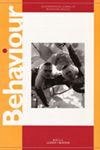Opposing effects of vigilance and foraging on escape behaviour in hooded crows
IF 1
4区 生物学
Q4 BEHAVIORAL SCIENCES
引用次数: 0
Abstract
Escape represents an important component of animals’ antipredator behaviour entailing both benefits and costs dependent on a moment an animal flees upon predator’s approach. In this study, I examined how the level of vigilance and foraging activity affected escape decision in the urban hooded crow Corvus cornix, predicting that alert distance (AD) and flight initiation distance (FID) should be positively affected by the level of vigilance and negatively affected by foraging activity, whereas buffer distance (BD) should be negatively affected by the level of vigilance and positively affected by foraging activity. Using LMMs it was shown that percent of time crows allocated to vigilance was positively correlated with AD and FID, whereas foraging activity of crows had negative impact on AD and FID. In addition, both AD and FID were positively related to starting distance (SD), while AD was also positively influenced by tree coverage. BD was positively affected by foraging activity and AD. This study demonstrated that more vigilant birds detected predators earlier, which is in accordance with the major function of vigilance. Also, it was shown that foraging crows delayed their escape, once the predator has been detected, as benefits of delayed flight, such as feeding on a profitable food item or within a profitable patch, may outweigh costs, which is consistent with the optimal escape theory.警惕和觅食对戴帽乌鸦逃跑行为的相反影响
逃跑是动物反捕食者行为的一个重要组成部分,它的收益和成本都取决于动物在捕食者接近时逃跑的那一刻。本研究考察了警惕水平和觅食活动对城市冠鸦逃跑决策的影响,预测警戒距离(AD)和飞行起始距离(FID)受到警惕水平的正影响,觅食活动的负影响;缓冲距离(BD)受到警惕水平的负影响,觅食活动的正影响。利用lmm模型研究发现,乌鸦的警戒时间百分比与AD和FID呈正相关,而乌鸦的觅食活动对AD和FID有负相关影响。此外,AD和FID都与起始距离(SD)呈正相关,而AD也受到树木盖度的正影响。采食活动和AD对BD有正向影响。研究表明,警惕性越强的鸟类发现捕食者的时间越早,这与警惕性的主要功能是一致的。此外,研究还表明,一旦发现捕食者,觅食的乌鸦会推迟逃跑,因为延迟飞行的好处,比如在有利可图的食物上觅食或在有利可图的斑块上觅食,可能会超过成本,这与最优逃跑理论是一致的。
本文章由计算机程序翻译,如有差异,请以英文原文为准。
求助全文
约1分钟内获得全文
求助全文
来源期刊

Behaviour
生物-动物学
CiteScore
1.80
自引率
7.70%
发文量
44
审稿时长
3 months
期刊介绍:
Behaviour is interested in all aspects of animal (including human) behaviour, from ecology and physiology to learning, cognition, and neuroscience. Evolutionary approaches, which concern themselves with the advantages of behaviour or capacities for the organism and its reproduction, receive much attention both at a theoretical level and as it relates to specific behavior.
 求助内容:
求助内容: 应助结果提醒方式:
应助结果提醒方式:


